




























































As well as her round-the-world adventures, this stunning GL Watson-designed ketch has proved herself as a competitive racer and a good all-round family yacht

Cruiser for the Clyde” read the Yachting World headline in September 1937, and yet this is a boat that has proved to be so much more than that. Islander was designed by GL Watson and Co and built by Messrs AM Dickie and Co at Tarbert, Loch Fyne in 1937. George Lennox Watson himself had died in 1904 so the company’s senior designer James Rennie Barnett would have had overall responsibility for her design. She was built with teak planking on American oak frames, and had a 15hp paraffin engine and Pygmylyte lighting.
Her first owner was Archibald J Barr of Kilmacolm. He and his family had previously had a 1934 Silver-built 49ft (15m) twin screw ketch of the same name, but this was changed to Islanda when she was put up for sale. The new Islander was described by The Yachtsman as “a wholesome ketch built for comfortable cruising…The appearance of the yacht is pleasing, and gives an idea of a staunch ship, easy on the helm, and handy,” while a Yachting World correspondent reported that “she is a very nicely proportioned cruiser with a moderate and easily handled sail spread”.

In July 1938 Islander was one of 35 yachts to take part in Clyde Cruising Club’s races from the Clyde to Kingstown (now Dún Laoghaire) and back, winning her class in the first race and coming third on the way home.

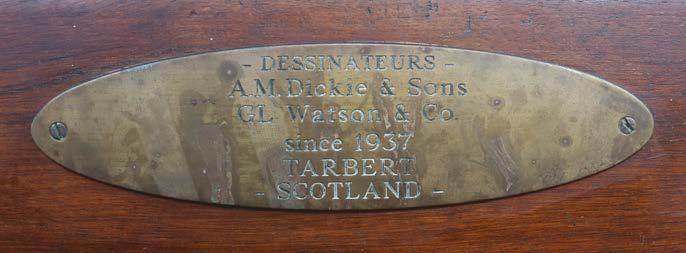
Just before the Second World War, Barr sold Islander to Sir Knowles Edge, a chemical manufacturer from Bolton in Yorkshire. Edge was vice commodore of both Lytham Yacht Club and Lytham St Annes Motor Boat Club, and had previously owned a 1910 50ft (15.3m) steel yacht called Chantecler. In 1950, he sold Islander back to Barr who, in the meantime, had briefly owned Muresse, a 1936 Berthonbuilt 34ft (10.4m) cutter. Five years later, Barr sold Islander to Ronald Strauss, a city financier who spent his summers in Cornwall (and on Barr’s subsequent death, his widow put “yacht owner” as his occupation on his death certificate).
After almost 30 years of undertaking nothing more than modest voyages, Islander’s horizons began to expand significantly in 1965 when she was purchased by Tom Blackwell. Blackwell was an heir of the Crosse & Blackwell food manufacturing company, and in the Second World War he had served in the Royal Navy and Royal Engineers, being awarded an MBE and the George Medal.

With the carbon tax deadline for shipping almost upon us, could wind-driven propulsion be the big comeback?


The new Hood LM35 that won our 2023 award for best new powered vessel is a technological marvel with a heart of wood
WORDS STEFFAN MEYRIC HUGHES


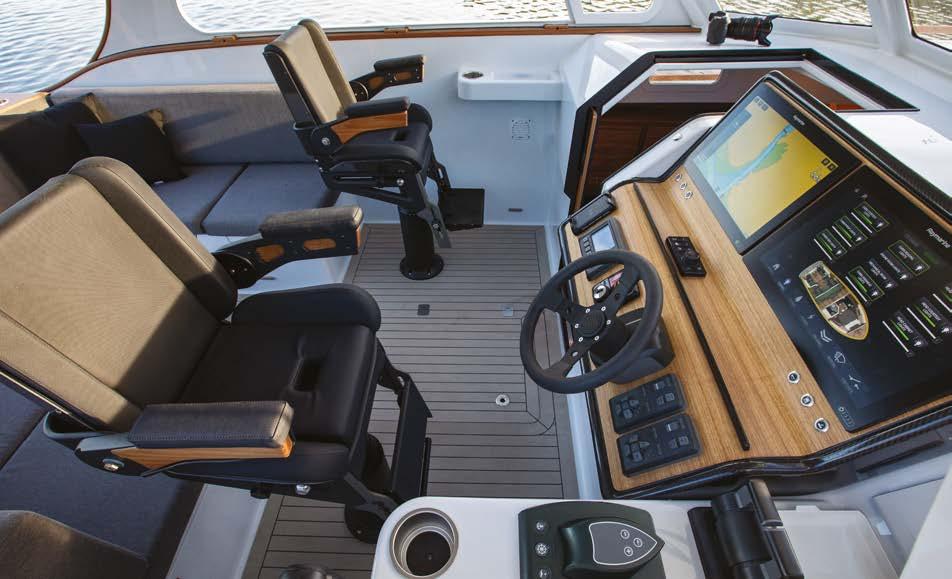
Following our discussion of Surform planes it is worth considering the Surform files which, with their inline handles, flat, half-round and round blades are the more versatile shaping tools for curved work and enlarging apertures.
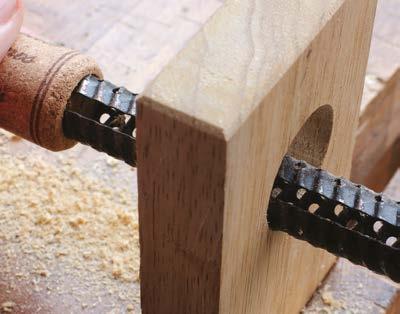
The Surform (named after its SURface FORMing function) was invented by Christopher Hodgson Booth some time in the 1940s and launched into the DIY market by Simmonds Aerocessories of Treforest, Wales, thence to be acquired by Stanley whose marketing clout ensured there would be a Surform of some sort in almost every worker’s tool kit. An interesting aspect of Booth’s patent is that it described not just possible formats of the tool but how this ‘strip or sheet of thin flexible steel or other hardenable iron alloy to be used in or as a cutting tool’ would be made, using punches or dies to strike out portions of the steel ‘to produce sharpened edges on the material at the peripheries of the holes therein, setting the sharpened edges to project from the general plane of the material’. Heat generated during subsequent grinding would harden
the edges which, being staggered, would ‘combine to provide in e ect continuous cutting edges’. Also significant is inventor Booth’s slightly oblique reference to the principle of ‘providing cutting edges by striking out parts of the peripheries of holes in sheet material’ already being widely employed ‘for culinary purposes’ by which he implies the cheese grater.
Compared to the saw rasp (see CB409 July 2022), a composite of zig-zag saw blades serving a similar purpose, I find the 10in Surform flat file less aggressive but also less prone to clogging. The Surform’s 450 edges working like tiny low-

1 The Surform file generates tidy shavings
2 Terminal grips for saw rasp (left) and Surform (right)
3 Enlarging an aperture with a round Surform file
angle planes take tidy shavings whereas the rip-toothed saw rasp generate a fibrous flu which lodges in its acutely angled structure. Other Surform advantages are that the blade is replaceable (around £5) while the solid body of the tool soldiers on indefinitely, and it has a comfortable upswept grip for the second hand. When the working teeth of a saw rasp lose their edge the tool must be replaced in total (around £30), meanwhile abrasive teeth bunched together by a rivet at the tip of the tool provide a somewhat user-unfriendly grip for fingertips. That said, the best answer to ‘Surform or saw rasp?’ is probably ‘Both!’





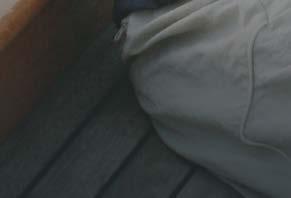



There are few who could match Harold Cudmore’s expertise and versatility as a competitive helmsman and skipper, either in modern boats or classics
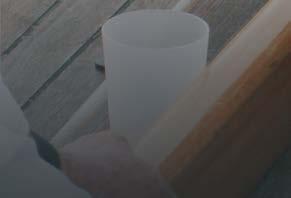


WORDS AND PHOTOS NIGEL SHARP



technological innovation as the only way forward: “This is an opportunity for a zero-compromise supply chain, not just emission-free but also rethinking what we carry, where it is from and who it is going to. We want diversity, equality and fairness from start to finish.”
This message is paying dividends. In 2023 NDT will host Grayhound, a 2012, 5/6th scale replica of a three-masted UK Customs Lugger built in 1776 in Cornwall, carrying Portuguese olive oil, wine, rice, almonds, pulses and honey. De Tukker, built in 1912 as a coastal trader and run by Eco Clipper, a Dutch company under the helm of Jorne Langelaan (one of the three founding members of Fairtransport) will sail between Portugal, France, the Netherlands and the UK and will add Breton salt from Noirmoutier to the mix. Also on the books is Timbercoast’s Avontuur, a twomasted gaff-rigged schooner originally built in the Netherlands in 1920, crossing the Atlantic to collect coffee, panela, and cacao from Colombia and Mexico.


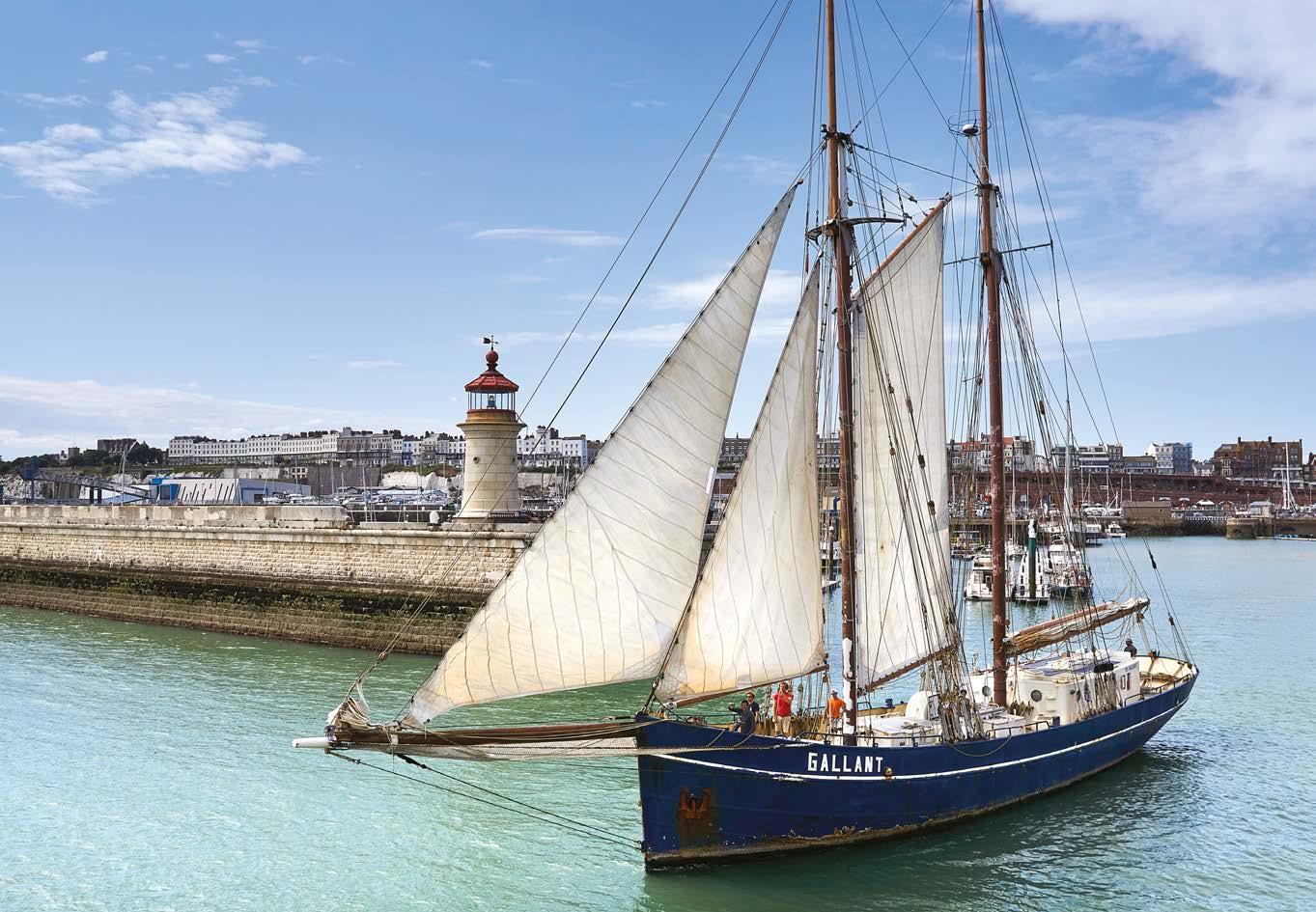
Other projects are in the pipeline, with the younger generation on board. Sailing instructor Ash Faire Ring is only 22 and has already completed a four-year re-build of his 1922, one-third size sailing barge Growler in Norfolk. Ash plans to move barley locally and beer to London, docking directly at Borough Market. “It would be wonderful to see the historic little ports dotted along the north Norfolk coast active again with traditional sails. Cley, for example, was one of the busiest ports in Europe back in the 17th century,” he explains.
Above and inset: VA1b Gallant unloading then leaving Ramsgate
Below: Grayhound was built in 2012
Alex Geldenhuys agrees: “A ship carrying 20,000 plus containers is limited as to where it can dock. There is a latent infrastructure of some 950 landing points across the UK ready and waiting for smaller craft. It just needs a system for administration, coding and management.” Growler has a draft of just two feet and there are other Thames barges already back in service, with 1897